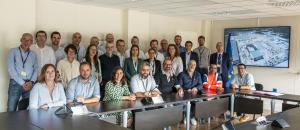Civil engineering officially complete
Ten years and 7,000,000 work hours later, many of the buildings in TB03 scope have been completed and turned over to the ITER Organization for the installation of plant equipment. The central Tokamak Complex—the most demanding project, requiring 100,000 m³ of concrete and approximately 30,000 tonnes of steel reinforcement to complete its three buildings (Tokamak, Tritium and Diagostics)—is being delivered in phases.
Since the contract kickoff meeting in 2013, the floors and walls of the impressive seven-storey structure have progressively taken shape. (You can follow progress over the years in this ITER construction gallery.)
Following the control of the instrumentation of all doors, and other verification, the papers certifying the official completion of the civil engineering works in the Tokamak Building were issued.
See the Fusion for Energy website for a full report.



